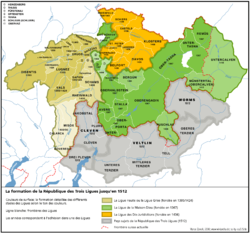
Back Lliga Grisa Catalan Drei Bünde#Oberer oder Grauer Bund German Liga Gris Spanish Ligue grise French Lega Grigia Italian 灰色同盟 Japanese 회색동맹 Korean Сива лига Macedonian Liga Cinza Portuguese Серая лига Russian
Grey League | |||||||||||||||||||
|---|---|---|---|---|---|---|---|---|---|---|---|---|---|---|---|---|---|---|---|
| 1395–1799 | |||||||||||||||||||
 The Grey League, shown in shades of brown within the Three Leagues. The League of the Ten Jurisdictions is shown in orange, the League of God's House in green and subject territories, subsequently lost, in grey. | |||||||||||||||||||
| Status | Associate of the Old Swiss Confederacy | ||||||||||||||||||
| Capital | Ilanz | ||||||||||||||||||
| Government | Republic | ||||||||||||||||||
| Historical era | Middle Ages | ||||||||||||||||||
• Grey League founded | 1395 | ||||||||||||||||||
• Government formed | March 16, 1424 | ||||||||||||||||||
| 1450 | |||||||||||||||||||
| late 15th century | |||||||||||||||||||
| September 23, 1524 | |||||||||||||||||||
| April 21, 1799 | |||||||||||||||||||
| |||||||||||||||||||
The Grey League (German: Grauer Bund, Italian: Lega Grigia, Romansh: Ligia Grischa or Lia Grischa [ˈliːɐ ˈɡʁiːʒɐ] ), sometimes called Oberbund, formed in 1395 in the Vorderrhein and Hinterrhein valleys, Raetia. The name Grey League is derived from the homespun grey clothes worn by the people. The league became part of the canton of Graubünden. The Grey League allied itself to the two other powers of Raetia in 1471, forming the Three Leagues. It was also an associate and ally of the Swiss Confederation and played a role in the buildup to the Thirty Years' War.

